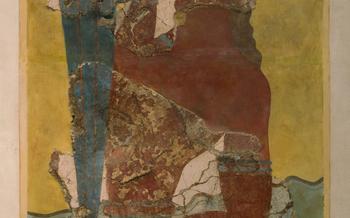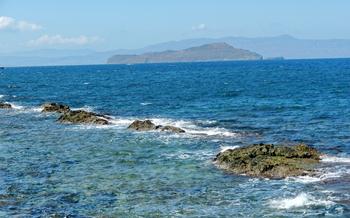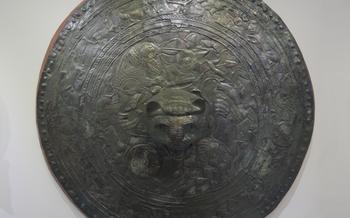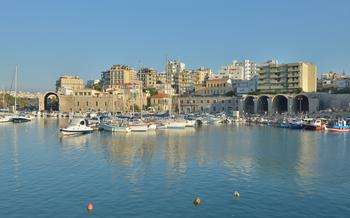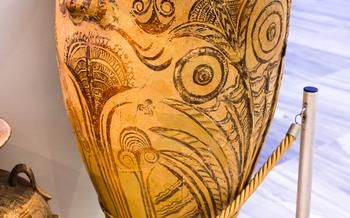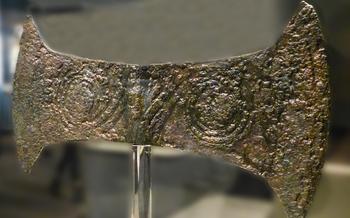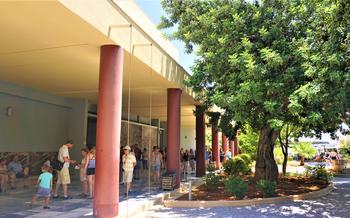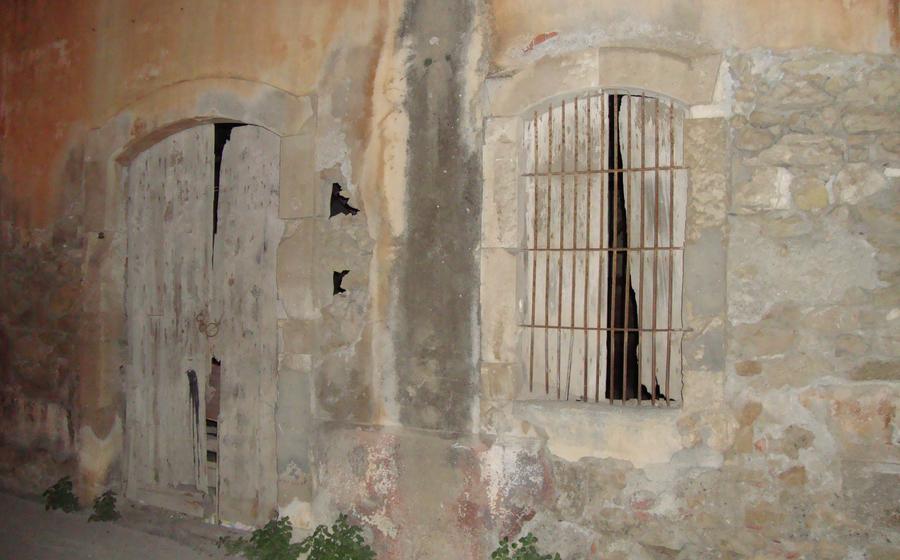
Sfentoni Cave
- Historical Background
- Location and Accessibility
- Natural Beauty
- Guided Tours
- Interior Exploration
- Minoan Artifacts:
- Mythological Significance
- Cultural Importance
- Photography Opportunities
- Practical Information
- Prehistoric Bones
- Archaeological Excavations
- Geological Formations
- Speleological Exploration
- Insider Tip
Historical Background
The Sfentoni Cave, nestled in the heart of Crete, Greece, is a treasure trove of ancient history and mythological lore. Its significance dates back to the Minoan civilization, a Bronze Age civilization that flourished on the island from around 2700 BC to 1450 BC. The Minoans, renowned for their advanced culture and maritime prowess, left an indelible mark on the island's history and mythology.
The cave's mythological significance is intertwined with the tale of the Minotaur, a mythical creature with the body of a man and the head of a bull. According to legend, the Minotaur was imprisoned in a labyrinth beneath the palace of Knossos, the capital of the Minoan civilization. The hero Theseus, with the help of Ariadne, the daughter of King Minos, navigated the labyrinth and slew the Minotaur, symbolizing the triumph of good over evil.
Archaeological discoveries within the Sfentoni Cave have further cemented its historical importance. Excavations have unearthed a wealth of artifacts, including pottery, tools, and religious symbols, providing valuable insights into the daily lives and beliefs of the Minoans. These findings have contributed to a deeper understanding of this ancient civilization and its profound influence on the development of European culture.
Location and Accessibility
The Sfentoni Cave is situated on the island of Crete, in the regional unit of Heraklion. It is approximately 50 kilometers southeast of the city of Heraklion, near the village of Sfenti. The cave is easily accessible by car, and there is ample parking space available at the entrance. Visitors can also reach the cave by public transportation, taking a bus from Heraklion to Sfenti and then walking the remaining distance. The journey from Heraklion to the cave takes about an hour and a half by car and two hours by bus.
Natural Beauty
The Sfentoni Cave, as a natural wonder, boasts of intricate geological formations that tell a story of millions of years. As you walk through its chambers, your eyes will catch the gleaming stalactites and stalagmites, formed by the slow dripping of mineral-rich water over eons. These calcite deposits, in various shapes and sizes, create a mesmerizing display of nature's artistry. Adding to the enchantment is an underground river, meandering through the cave, adding a soothing sound of flowing water to the symphony of nature. The river's crystal-clear waters reveal hidden depths and reflect the glimmering cave walls, creating a magical ambiance that captivates visitors.
Guided Tours
The Sfentoni Cave offers guided tours that provide an immersive and informative experience for visitors. These tours are led by knowledgeable guides who share insights into the cave's history, geology, and archaeological significance. Guided tours are available in multiple languages, including English, Greek, and French, ensuring that visitors from various backgrounds can appreciate the cave's wonders.
To ensure a spot on a guided tour, it is advisable to book in advance, particularly during peak tourist season. Booking can be done online or through local tour operators. The cost of a guided tour typically includes entrance to the cave, the services of a guide, and a flashlight for navigating the darker areas of the cave.
Interior Exploration
The Sfentoni Cave offers a captivating journey through its various chambers, each boasting unique features and archaeological treasures. As you delve deeper into the cave, you'll encounter awe-inspiring stalactites and stalagmites, forming intricate and mesmerizing patterns that adorn the cave walls and ceilings. These stalactites and stalagmites, formed over thousands of years by the slow dripping of water, add to the cave's surreal beauty and create an otherworldly ambiance.
One of the cave's most remarkable features is its underground river, which flows through the cave's chambers, adding a touch of tranquility and mystery to the already enchanting atmosphere. The river's gentle murmur echoes through the cave, creating a soothing and serene backdrop for your exploration.
As you explore the cave's chambers, you'll stumble upon archaeological findings that provide glimpses into the lives of the Minoan people who once inhabited this sacred space. These discoveries include pottery shards, tools, and religious symbols, offering valuable insights into the cultural and religious practices of this ancient civilization.
The walls of the cave are adorned with artistic representations, such as engravings and paintings, which further enhance the cave's cultural significance. These artworks depict scenes from Minoan mythology, providing a glimpse into the beliefs and traditions of this enigmatic civilization.
Minoan Artifacts:
The Sfentoni Cave has yielded a wealth of Minoan artifacts that provide valuable insights into their daily life and culture. Among the most notable findings are pottery fragments, tools, and religious symbols. The pottery, with its intricate designs and vibrant colors, showcases the artistry and craftsmanship of the Minoan people. Tools such as stone axes, knives, and scrapers reveal their technological advancements and agricultural practices. Perhaps most fascinating are the religious symbols, including ceramic figurines, animal bones, and offerings, which shed light on their spiritual beliefs and rituals. These artifacts, carefully preserved and displayed in museums, offer a tangible connection to the rich history and legacy of the Minoan civilization.
Mythological Significance
The Sfentoni Cave holds a significant place in Greek mythology, with captivating legends and myths woven around its existence. According to one of the most famous tales, the cave was associated with the mythical creature, the Minotaur. The Minotaur, half-man, half-bull, was said to have been born to Queen Pasiphae, wife of King Minos. The creature was confined to a labyrinth beneath the palace of Knossos, believed to be connected to the Sfentoni Cave. The hero Theseus, with the help of Ariadne, daughter of King Minos, navigated the labyrinth and defeated the Minotaur, bringing an end to its reign of terror.
The Sfentoni Cave was also believed to have been a sacred site where Minoans performed religious rituals and ceremonies. Evidence of these practices can be seen in the cave's various chambers, which contain altars, niches, and other sacred symbols. The discovery of Minoan pottery and tools further supports the theory that the cave served as a religious sanctuary.
Cultural Importance
The Sfentoni Cave holds immense cultural significance, deeply rooted in the historical context of Crete and Greek mythology. In ancient times, caves were often associated with religious rituals and spiritual practices. The discovery of numerous Minoan artifacts and artistic representations within the Sfentoni Cave suggests that it may have served as a sacred site or a place of worship for the Minoan civilization. The cave's natural features, such as the stalactites and stalagmites, may have been viewed as sacred symbols or representations of deities.
Moreover, the cave's connection to the myth of the Minotaur further enhances its cultural importance. According to Greek mythology, the Minotaur, a half-man, half-bull creature, was imprisoned in a labyrinth beneath the palace of King Minos in Knossos. Some scholars believe that the Sfentoni Cave may have inspired the myth of the labyrinth, as its intricate network of chambers and tunnels could easily be likened to a maze. The presence of bull-like stalactites within the cave further strengthens this connection.
Due to its rich cultural and historical significance, the Sfentoni Cave has become a valuable asset to the island of Crete. It serves as a reminder of the island's ancient past, its connection to Greek mythology, and the importance of preserving and protecting cultural heritage sites.
Photography Opportunities
The Sfentoni Cave offers a unique opportunity for photography enthusiasts to capture stunning images of its natural beauty and archaeological significance. The cave's dimly lit interior creates a dramatic and mysterious atmosphere, while the intricate formations of stalactites and stalagmites provide a visually captivating subject.
Photographers can take advantage of the natural lighting conditions within the cave to create evocative shots. The interplay of light and shadow highlights the textures and contours of the rock formations, creating an ethereal and otherworldly ambiance.
To capture the most striking images, it is recommended to use a tripod to stabilize the camera and avoid blurry shots. A wide-angle lens can be effective for capturing the vastness of the cave's chambers, while a telephoto lens can be used to zoom in on specific details and features.
For those interested in capturing the cave's unique atmosphere, long exposure photography can be a powerful technique. By using a slow shutter speed, photographers can capture the movement of the underground river and create a sense of dynamism within the static environment.
Whether you are an experienced photographer or simply looking to capture some memorable shots of your visit, the Sfentoni Cave is a treasure trove of photographic opportunities.
Practical Information
Visiting the Sfentoni Cave is a captivating experience that requires careful planning. The cave's opening hours are typically from 9 am to 5 pm during the summer months, while in the off-season, it may have reduced hours or even be closed, so it's advisable to check before your visit. Ticket prices are reasonable, and discounts are often available for students and seniors.
Once inside the cave, you'll find basic facilities to ensure a comfortable visit. There are restrooms, a small café for refreshments, and a gift shop where you can purchase souvenirs and educational materials related to the cave and its history. Guided tours are available in various languages, providing insightful information and ensuring you don't miss any significant features during your exploration.
Prehistoric Bones
The Sfentoni Cave has yielded a treasure trove of prehistoric bones, providing valuable insights into the fauna that existed during the Minoan era. These fossil remains include bones of various animals, such as deer, goats, and wild boars, which were likely hunted by the Minoans for sustenance. The discovery of these bones has been instrumental in understanding the dietary habits and hunting practices of the Minoan civilization.
Additionally, the cave has revealed the presence of extinct species, such as the dwarf elephant and the pygmy hippopotamus, which were endemic to the island of Crete. These discoveries have shed light on the unique and diverse ecosystem that existed in Crete during the Pleistocene epoch. The study of these prehistoric bones has contributed significantly to the field of paleontology and has provided valuable information about the evolutionary history of Crete's fauna.
Archaeological Excavations
Even today, the Sfentoni Cave draws the attention of archaeologists and historians for its potential to yield further insights into the Minoan civilization. Ongoing excavations, carried out collaboratively by teams of experts, continue to uncover valuable artifacts and information. These excavations not only add to our understanding of Minoan culture but also raise new questions, propelling the exploration and research process forward. By piecing together the evidence from artifacts, structural remains, and contextual clues, archaeologists aim to shed light on the cave's role in Minoan society and the lives of the people who inhabited it.
Geological Formations
The Sfentoni Cave is a geological marvel, showcasing unique rock formations that have been shaped over millions of years by the forces of nature. The cave's walls are adorned with a mesmerizing array of stalactites and stalagmites, which create an ethereal and awe-inspiring atmosphere. These formations come in various shapes and sizes, and their delicate structures seem to defy gravity. The cave also features a fascinating karst landscape, characterized by underground rivers, sinkholes, and caverns. These formations are a testament to the power of water and its ability to carve intricate shapes in the rock. Exploring these geological wonders is a journey into the earth's history, providing a glimpse into the processes that have shaped our planet over eons.
Speleological Exploration
For experienced cavers, the Sfentoni Cave offers a thrilling opportunity for speleological exploration. With its vast network of hidden chambers and passages, the cave provides a unique and challenging environment for those seeking adventure. However, it is important to approach this activity with caution and take necessary safety precautions. Proper equipment, including a helmet, sturdy footwear, and a reliable flashlight, is essential for navigating the cave's uneven surfaces and dimly lit areas. Additionally, it is highly recommended to explore the cave with a knowledgeable guide who can provide insights into the cave's geology and history, ensuring a safe and rewarding experience. Embarking on a speleological journey through the Sfentoni Cave allows visitors to delve deep into the heart of this natural wonder, uncovering its hidden secrets and gaining a profound appreciation for the intricate beauty of the underworld.
Insider Tip
To fully appreciate the beauty and tranquility of the Sfentoni Cave, it's best to avoid visiting during the peak tourist season, which typically runs from July to August. The cave is less crowded and more serene outside of these months, allowing you to explore at your own pace and take in the breathtaking sights without distractions.
Additionally, carry a flashlight or headlamp to navigate the dimly lit areas of the cave. While there is some artificial lighting, it's not always sufficient to illuminate every corner and crevice. A flashlight will help you explore the cave's hidden chambers and passages safely and ensure you don't miss any of the intricate details that make it so special.
Lastly, wear comfortable shoes for walking on uneven surfaces. The cave's interior terrain can be rugged and slippery in places, so proper footwear is essential for maintaining your balance and preventing any accidents. With these tips in mind, you'll be well-prepared to embark on an unforgettable journey into the depths of the Sfentoni Cave.
